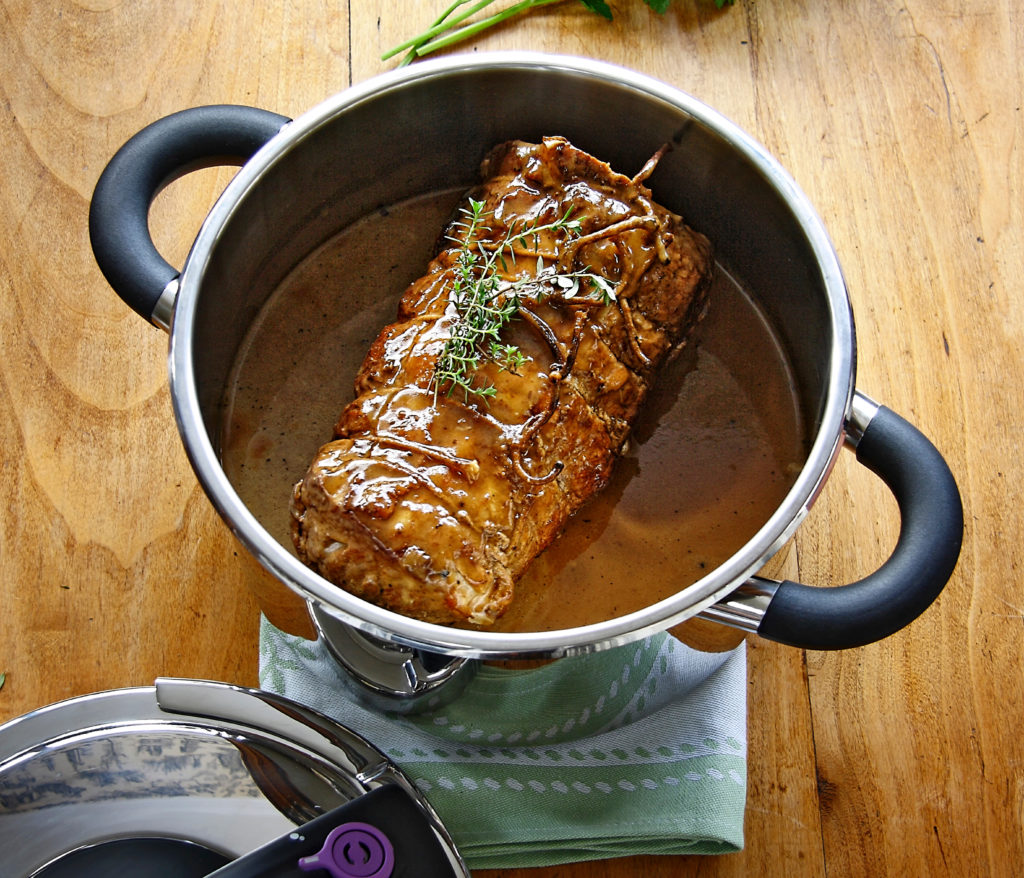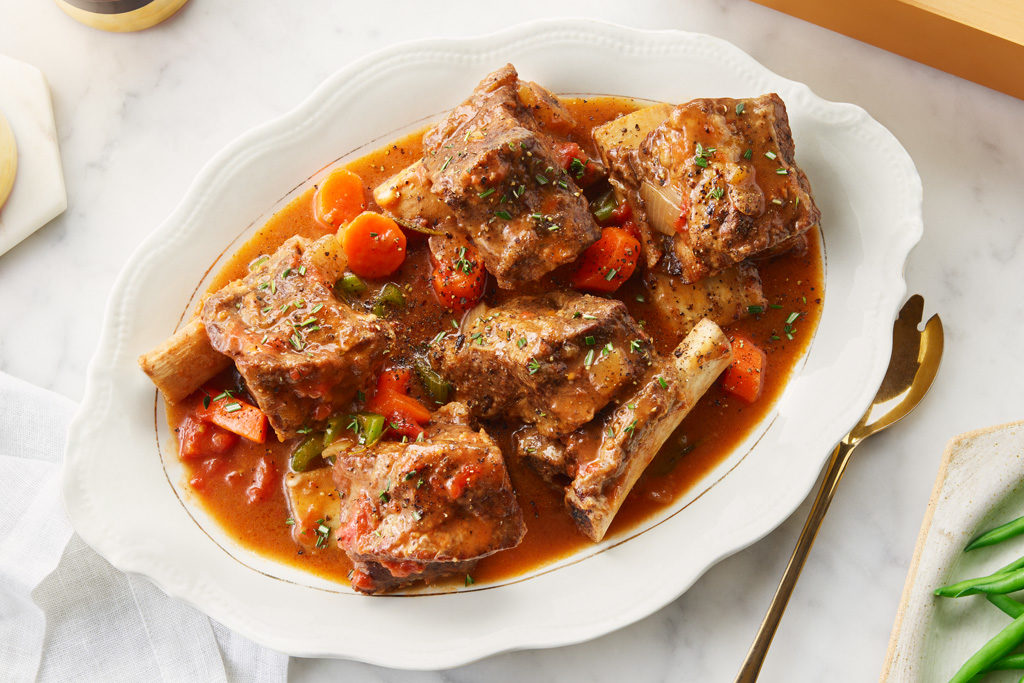Pressure Cooking: Introduction, Buying and Tips
Pressure cooking has come a long way since the days of intimidating pots with noisy, steaming gaskets sputtering away on the lid. Today’s pressure cookers are safer, quieter and more versatile than the vintage models of yesteryear. Braised Ribs in an hour? Yes, it’s possible with a pressure cooker!
What is Pressure Cooking?
Pressure cooking is cooking food in a specialized sealed vessel with liquid. As the foods and liquid are heated inside the sealed pressure cooker, steam builds up and creates pressure inside the pot. Because the pot is closed, the temperature of the steam can rise (in an open pot steam never gets hotter than 212°F.) which, in turn, causes foods to cook more quickly.
Buying a Pressure Cooker
There are two types of pressure cookers: stovetop models and electric. Stovetop cookers have one function: to cook food under pressure. Electric models do that too but often have other features for performing cooking tasks such as steaming, slow cooking and warming. For the purposes of this article, we’re going to focus on stovetop models. (Refer to the owners’ manual for instructions specific to electric pressure cookers.)
- Pressure cookers range in size from 6-qt. to 8-qt. Our recommendation is one that’s on the larger side—you can’t cook large amounts of food in a small pot, but you can cook small amounts in a large pot.
- When buying a pressure cooker, pay attention to the thickness and width of the heavy metal plate at the base of the pot. Thicker plates will conduct heat better and more quickly, and help to maintain pressure inside the pot. This disk also makes the cooker heavier than a typical stovetop pot.
- Look for pressure cookers that have an easy-to-latch lid with gauges that are accessible and readable when the pot is at high pressure. Designs vary from manufacturer, but the best include pressure valves on top of the lid that pop out and are visible from several feet away.
- Proper sealing of the pot is critical to pressure cooking, and the lids will usually have a thick, removable rubber gasket that allows for a tight seal when closed. Be sure the gasket is made of high-quality rubber and be sure to clean it well between uses – after cleaning rub a light film of vegetable oil on the gasket with a paper towel to help keep it pliable. Replace the gasket if it becomes dry or cracked, purchasing it from the same manufacturer that made the pot. Gaskets are not “one size fits all.”
So How Do I Do It?
Pressure cooking can seem intimidating at first, but once you get the hang of it, you’ll be amazed at how versatile the appliance can be. Here’s a basic snapshot of what’s involved for pressure cooking a 3-lb. boneless beef pot roast:
- Season the beef with salt and pepper. Heat 1 Tbsp. oil in the pot of the pressure cooker over medium-high heat.
- Add the roast and brown well on both sides – the metal disk on the bottom of the pressure cooker pot will heat quickly and will stay hot, so keep an eye on the roast to prevent scorching. Once the roast is brown, remove it from the pot.
- Add 2 cups aromatic vegetables (onions, celery, carrots) and sauté for 3 to 4 min., stirring often. (If you want the vegetables to retain their shape during cooking, keep them in large pieces; if you want them to soften and “melt” into the sauce, cut them into small pieces.)
- Deglaze the pot with 1 to 2 cups liquid – broth or stock, wine or a combination of both. Return the roast to the pot and lock the lid in place. (Do not fill the pressure cooker pot more than 2/3 full to ensure even cooking.)
- Bring the pot to high pressure over medium-high heat. When at high pressure, reduce the heat to medium or medium-low (stovetop burners vary in intensity) and cook for the time recommended in the recipe – a 3-lb. beef roast will require 45 to 55 min. of cooking. Begin timing once the pot reaches high pressure.
- Remove the pot from the burner and allow the pressure inside to come down naturally (this is known as “natural release”). When the pressure in the pot has dissipated, very carefully unlatch and remove the lid. (Be careful when opening the pot – there is still a lot of steam inside which can burn. Open the lid so the steam is directed away from your face.)
- Check the meat for doneness. If it requires more cooking, return the pot to the stove and let it simmer until it’s done to your liking. If the meat is cooked properly, carefully transfer it to a serving platter. Taste the sauce – if it seems watery in texture and flavour, reduce it over high heat to concentrate its flavours.
Tips & Troubleshooting
If you’re new to pressure cooking you’ll undoubtedly run into some questions as you get accustomed to the appliance and the procedure. Here are some tips and troubleshooting techniques that may help.
- Familiarize yourself with all the parts and pieces of your pressure cooker by reading the manufacturer’s instructions before cooking anything.
- Be prepared to adjust your stove’s burners as needed in order to maintain the adequate temperature. All stoves and pressure cookers vary in their performance which will affect how each performs.
- In order to properly function, all pressure cookers require liquid. Always use the amounts called for in the recipes. Cooking hard vegetables such as squash, potatoes and beets requires enough water to create steam for the duration of cooking – 2 to 3 cups is generally adequate, but experimentation will help you gauge just how much is adequate. (When cooking vegetables, it’s usually recommended to release pressure using the “quick release” method to prevent overcooking. After cooking for the recommended amount of time, remove the cooker from the burner and carefully depress the pressure valve using the back of a wooden spoon. Be careful – this will forcefully emit steam from the inside the pot through the valve.)
- Clean the cooker’s vents and valves well after each use – they can often become coated with cooking residue and affect the functionality of your cooker.


